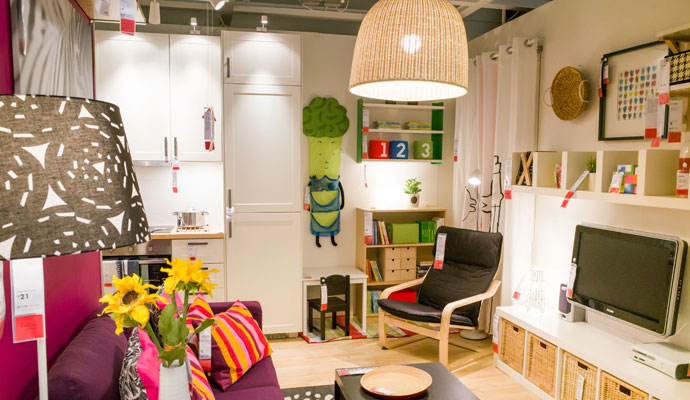How Ikea Reassembled Its Growth Strategy
During the Great Recession, this iconic Swedish furniture company developed a new way to expand: cutting costs while increasing customer loyalty.
Few brands reach the iconic stature of Ikea, the Swedish furniture company founded in 1943 that sells ready-to-assemble furniture. Known for its simple product design; its massive, friendly retail stores; and its very low prices (which have dropped an average of 2 to 3 percent each year since 2000), the company has built a remarkable level of customer loyalty around the world.
From its beginnings, the company concentrated on continuous cost reduction in a way that elevated it almost to an art form. As founder Ingvar Kamprad wrote in his autobiography, The Testament of a Furniture Dealer: A Little Ikea Dictionary (Ikea, 1976), “Wasting resources is a mortal sin at Ikea.… Expensive solutions to any kind of problem are usually the work of mediocrity. We have no respect for a solution until we know what it costs.”
But starting in 2008, facing rising prices and a global recession that hit its core markets (new homeowners and middle-class consumers) especially hard, Ikea set out on a new strategic path: to offer even lower prices to consumers, while positioning itself for long-term growth. It accomplished this through the simplest of methods: focusing relentlessly on separating “good costs” (productive investments) from “bad costs” (unnecessary expenses). The company then invested 100 percent of its net savings on building up the essential qualities of its business or lowering the price of its products. (At other companies, even 25 percent reinvestment is considered remarkable.) The results to date have been impressive: about 10 percent annual top-line growth and stable margins, despite the ongoing price reductions and economic pressure of the past few years.
As part of our background research for an s+b article (“Is Your Company Fit for Growth?” by Deniz Caglar, Jaya Pandrangi, and John Plansky, Summer 2012), we spoke in March with Ian Worling, one of the executives at Ikea who was closely involved with this initiative. Worling is Ikea’s director of business navigation — which combines the job of controller with a primary role in steering the business and in strategy development.
S+B: How did Ikea’s strategy initiative start?
WORLING: As a company, we have always been extremely clear about our ambition: to create a better life for people. That means we offer home furnishings at such low prices that as many people as possible can afford to buy them. That colors everything we do. We are single-minded about cost reduction, and we are never satisfied with where we are on that journey.
During the 2000s, we had very good growth in most of our markets. We were profitable, and inevitably, we got a bit fat on the cost side. Then the recession came on. When times are rough, it can be good for Ikea, if we can offer affordable-enough home furnishings. So we asked ourselves what we could do during this period to lower our costs and, instead of reducing the bottom line, to turn every euro back to lower prices for our customers. This goal of price reduction was the real key for us, from a motivation point of view.
We didn’t focus on cutting costs, because that’s the easiest thing to do in retail. You just lay people off, and cut back some of your capital expenditure, and it reduces your variable costs. But it also weakens you. Instead, we decided to make structural changes — to rethink our practices.
We’ve done this now for the past three years. Therefore, even in years like 2011, when we had significant increases in raw material prices, we were able to offer lower prices to our customers than we did the year before. The outcome has been higher market share in almost every country where we do business.
S+B: What kinds of changes did you have to make to accomplish this?
WORLING: One of our most important decisions was a change we chose not to make. We did not cut back on our investment in retail stores. We own all of our buildings and land, and our stores are custom built and designed for efficiency and sales potential. We want people to feel at home in our stores, which is why we include the restaurants and child-care facilities. We decided to keep our investment, not just in new stores, but in extending and expanding our existing stores. We think it’s just as important to improve the way we serve the customers we have today as it is to take on new customers.
To make up the difference, we had to become very good at four things. First was lowering operational costs. We had to have genuinely low costs wherever we could, especially where customers didn’t see. Everybody in our company travels economy class and stays in moderately priced hotels. We don’t have fancy offices.
Second, we had to become even better at increasing volume, because that allows us to lower our cost of goods and operating costs. To increase volume, we had to become better at handling more people and products. We have fewer than 400 stores — far fewer than Walmart or Carrefour — but the volume we put through each location is significant.
Third, we had to develop an even better-functioning supply chain. Over the years, maintaining our stock of items has been one of our bigger challenges. Improving this has been a real focus for the past couple of years, and we have made some progress. We could not do this as a more conventional retailer might, because we design and produce most of our products ourselves. At the same time, because we own some of our factories — including some that produce components — we could look at each part of the company and each process as a way to lower costs.
The fourth area involved empowering our co-workers. We try to keep the center of the company relatively lean, and not make too many decisions centrally that would be better made in stores or factories close to customers and suppliers. Therefore, we must have a strong group of co-workers who can make the right decisions to support our strategies.
S+B: How did you align these four priorities with people throughout the company?
WORLING: Our biggest advantage was Ikea’s culture and value. Culture is extremely important at Ikea, even more so than at other companies. We work hard to ensure that as new people come in, they understand who we are and what we’re trying to do. The people who work here genuinely want to be here and share Ikea’s core values of cost consciousness and humility. I suppose that we must do a lot of things reasonably well, but we never talk about that. We always talk about where we’ve disappointed people and how we can do better. When we have a particularly good triumph, you’ll hear someone say: “Okay, we’ll take one minute now for satisfaction, and then move on.”
Lowering costs is part of our cultural DNA. It’s ingrained in everybody from Day One that we don’t waste resources or money. I don’t think you could take a senior position in this company if you didn’t believe wholeheartedly in that. For any expense, we always ask ourselves, “Would our customers want to pay for that particular item themselves?” If the answer is no, then we try to find a way to do without it or to do it in a cheaper way.
It helps that we don’t change strategic direction very often. We tend to build on what we have, and that helps a lot with alignment. We don’t have to constantly explain, “Yes, last year we said we would do something else, but now we’ve changed our mind.”
S+B: How do these capabilities fit with your other distinctive strengths, such as customer insight and engineering design?
WORLING: You can’t be successful in retail without understanding what your customers think of you. Hundreds of millions of people visit Ikea stores every year, and even more visit our website, and we listen to them. Ingvar Kamprad, our founder, still walks around the stores and talks to customers there. “What didn’t you like here today?” We are always trying to do better.
As for engineering capability, we continue to design most products ourselves. Our product designers don’t just sit in an office with a computer. They work in our factories, and in the factories of our suppliers, designing products with the engineers there, to help make them more efficient to produce.
They also work on the packaging side to shave down the amount of packaging. Even a few millimeters can make a big difference in fitting more pieces into a container. We hate transporting air. We have a flat-pack business, which was originally developed to help customers take products home. It also reduces our own shipping costs.
Designers sometimes start with a pallet outline, and it’s like a jigsaw puzzle. How will the pieces fit together in the package and how many boxes can they get on that pallet?
S+B: How has this initiative changed the way you conduct business?
WORLING: Like any other company, we have far more potential priorities than we can fulfill. So at some point we have to say, even though everything on our list is valid, some items won’t create as much growth for us as the ones at the top. And we invest accordingly.
In the long run, this has given us much more control over our destiny. We can continue to build the stores we want to build; we don’t have to make compromises on quality. We don’t see low costs and high quality as incompatible; we find ways to increase resources where it is the right thing to do. ![]()
Author profiles:
- Deniz Caglar is a principal with Booz & Company in Chicago. He focuses on organizational design and cost fitness in the consumer packaged goods and retail industries.
- Marco Kesteloo is a partner with Booz & Company based in Amsterdam. He focuses on strategy, operations, and organizational management for companies in the logistics industry, as well as their customers.
- Art Kleiner is editor-in-chief of strategy+business.
- Also contributing were Booz & Company principals Bas Kemme and Tara A. Owen.



